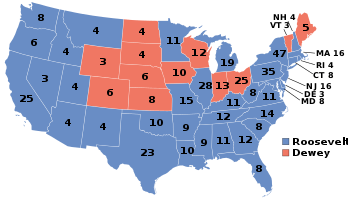1944 United States elections
The 1944 United States elections was held on November 7, 1944, taking place just a month after the Allies liberated Paris in World War II. President Franklin D. Roosevelt was re-elected to an unprecedented fourth term, while the Democrats retained their majorities in both chambers of Congress.
| Presidential election year | |
| Election day | November 7 |
|---|---|
| Incumbent president | Franklin D. Roosevelt (Democratic) |
| Next Congress | 79th |
| Presidential election | |
| Partisan control | Democratic Hold |
| Popular vote margin | Democratic +7.5% |
| Electoral vote | |
| Franklin D. Roosevelt (D) | 432 |
| Thomas E. Dewey (R) | 99 |
  | |
| 1944 presidential election results. Red denotes states won by Dewey, blue denotes states won by Roosevelt. Numbers indicate the electoral votes won by each candidate. | |
| Senate elections | |
| Overall control | Democratic Hold |
| Seats contested | 35 of 96 seats (32 Class 1 seats + 4 special elections)[1] |
| Net seat change | Republican +1[2] |
 | |
| 1944 Senate results
Democratic gain Democratic hold | |
| House elections | |
| Overall control | Democratic Hold |
| Seats contested | All 435 voting members |
| Popular vote margin | Democratic +4.7% |
| Net seat change | Democratic +20 |
| Gubernatorial elections | |
| Seats contested | 32 |
| Net seat change | Democratic +3 |
 | |
| 1944 gubernatorial election results
Democratic gain Democratic hold | |
President
Seeking a record fourth term, Democratic incumbent President Franklin D. Roosevelt was challenged by Republican Governor Thomas E. Dewey of New York. Dewey ran an energetic campaign, seeking a smaller government and a less-regulated economy as the end of World War II seemed in sight. Roosevelt dominated the electoral college for the fourth straight election and won the popular vote by seven and a half points, his lowest margin. Roosevelt easily won his party's nomination, while Dewey took the Republican nomination on the first ballot over Ohio Governor John W. Bricker, who would be nominated for vice president. Future president Harry S. Truman won the Democratic nomination for vice president, replacing Henry A. Wallace on the Democratic ballot.
United States House of Representatives
The Democrats picked up a net gain of 20 seats in the House, increasing their majority, 242–191 (not included are two seats held by minor parties).
United States Senate
Although the Democrats suffered a net loss of one seat to the Republicans, they still kept a large majority in the Senate.[3][4]
References
- One Class 1 seat held both a regularly-scheduled election and a special election in 1944. This seat is not double-counted for the total number of seats contested.
- There was no net change in the regularly-scheduled elections, but Republicans picked up one seat in the special elections.
- "1944 Presidential Election". The American Presidency Project. Retrieved 9 April 2017.
- "Statistics of the Presidential and Congressional Election of November 7, 1944" (PDF). U.S. House of Reps, Office of the Clerk. Retrieved 9 April 2017.